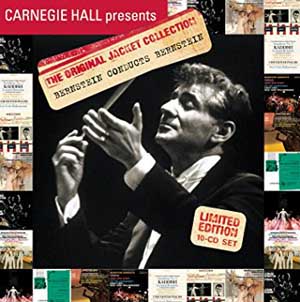 I’ve mentioned before that there are vanishingly few orchestra conductors in the twentieth century whose names have become household words. There are, if anything, even fewer composers who have achieved that degree of notoriety. Leonard Bernstein is all of the above: conductor, composer, and household word.
I’ve mentioned before that there are vanishingly few orchestra conductors in the twentieth century whose names have become household words. There are, if anything, even fewer composers who have achieved that degree of notoriety. Leonard Bernstein is all of the above: conductor, composer, and household word.
Composers these days tend to work in either popular or serious music. (Well, they pretty much always did — remember that Mozart’s Magic Flute was the eighteenth-century equivalent of a Broadway show. It’s just that the boundaries were blurrier then.) This is not hard and fast, by any means: one need only think of the film scores produced by such figures as Sergei Prokofiev, Aaron Copland, and Phillip Glass, or the piano concertos and opera of George Gershwin. But by and large, reputations are achieved in one area or the other. Bernstein straddled the boundary between vernacular and high culture, creating everything from Broadway musicals to symphonies, with stops all along the way. In Bernstein’s case, however, we really need to be aware of the degree of cross-fertilization among the various modes to really understand how important his voice was. Take it as symptomatic that West Side Story, one of the two or three most popular musical shows ever, could be recorded by an all-star cast in which the stars were all from the realm of opera (possibly the ultimate in “high culture,” and I happen to think that Kiri Te Kanawa as Maria was breathtaking), while the forces for Mass included not only choruses, but a symphony orchestra, dancers, and soloists from opera, blues, and rock.
The present collection displays admirably that seamless continuity, including re-issues of recordings by Bernstein of his own music, originally recorded for Columbia Records between 1956 and 1971. It’s billed as “The Original Jacket Collection,” which strikes me as a double-edged concept: the ten discs are sleeved in reproductions of the original LP jackets, but the couplings aren’t always the same. The Symphony No. 1 (Jeremiah), for example, was originally released with Roy Harris’ Third Symphony, while here it shares a disc with Bernstein’s own The Age of Anxiety (Symphony No. 2). (Strangely enough, the fronts of the jacket reproduction seem to contain the right information.)
Take that as my obligatory reviewer’s complaint. What matters here is that we have Leonard Bernstein presenting a survey of his music, solidly grounded in both sides of American culture of mid- and late century. However, I want to point one thing out that I think illustrates my perennial contention that the gaps between popular and high culture are pretty much in our own minds, as much as they exist at all: West Side Story is presented here as the Symphonic Dances from West Side Story; likewise, the music from Bernstein’s score for On the Waterfront is presented as a symphonic suite. It doesn’t take much thought to come up with the idea that this is simply a shift in mode: the works are translated from a popular mode into a “high-art” mode to make them suitable for the concert hall, as opposed to the move house or Broadway theater. They retain their essential character, and I think also that as you listen to these recordings, you’ll find that the idiom, no matter where we might think it belongs (and this is one of Bernstein’s great gifts), migrates easily, from the symphonies to the opera Trouble in Tahiti to the Chichester Psalms: Bernstein, like the others of that category we are pleased to call “American Independents,” took his material where he found it, and then moved it to the places he wanted it.
The great case in point, of course, is the Mass, which takes up two of the ten discs in this collection (and it is nice, finally, to have Bernstein’s version of it). I’ve discussed this work elsewhere, but it still, to my mind, brings to one place what is most significant about Bernstein and his music: It does capture its time, and not in some abstract, rarefied manner. It takes the many ways we expressed ourselves at mid-century and puts them together into a work that is compelling and that, I think, can speak to all of us directly.
And that is what Bernstein was all about.
(Sony BMG Music Entertainment, 2008)
